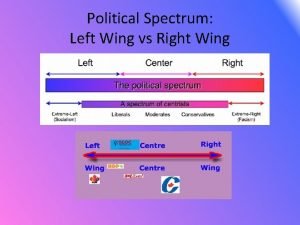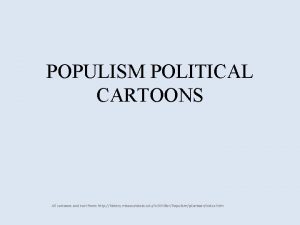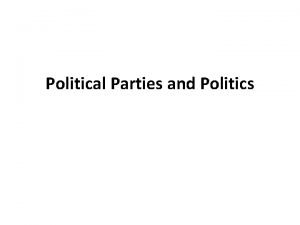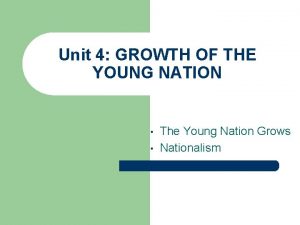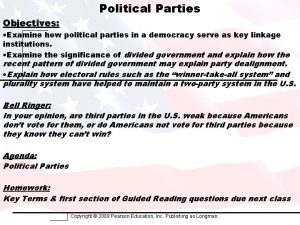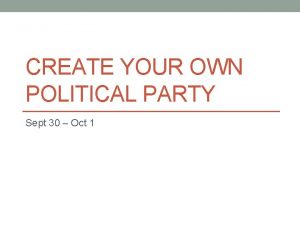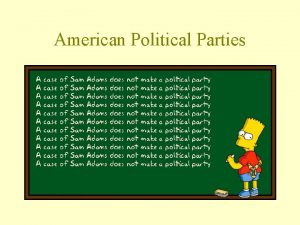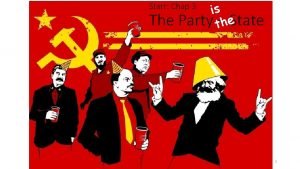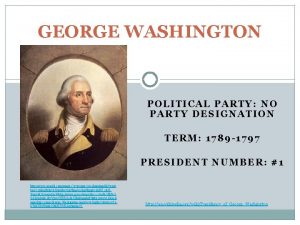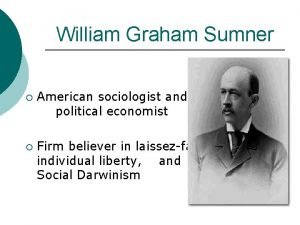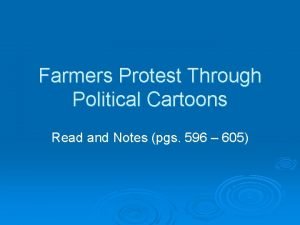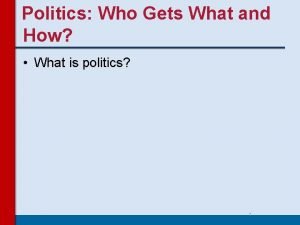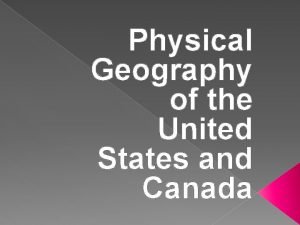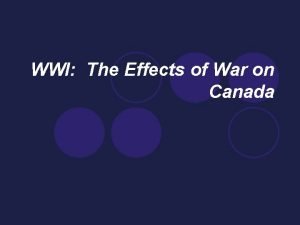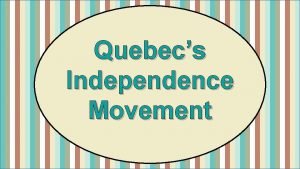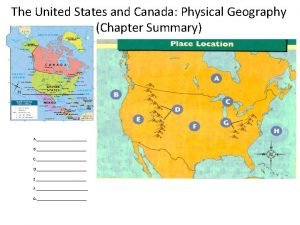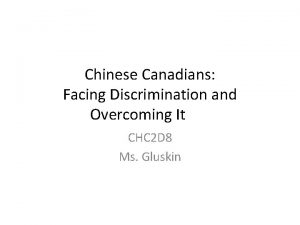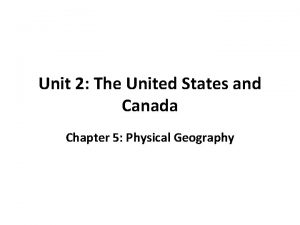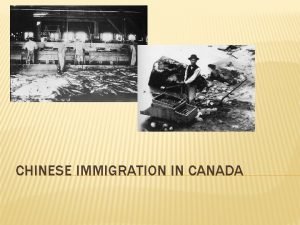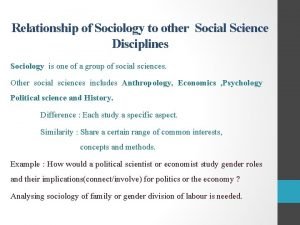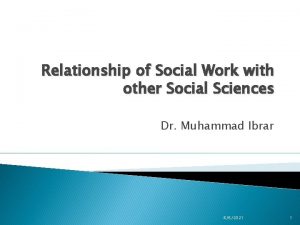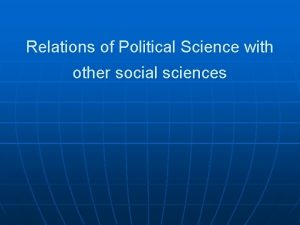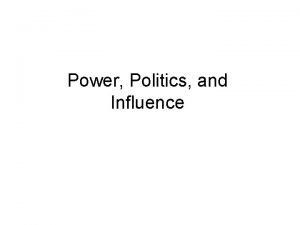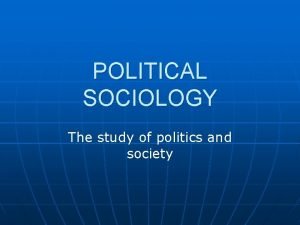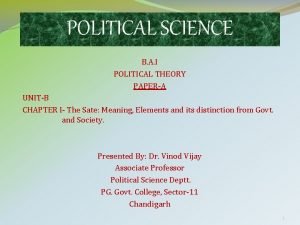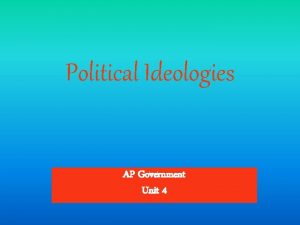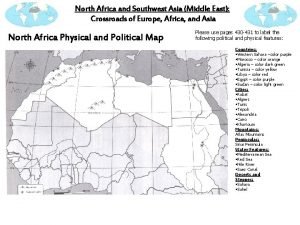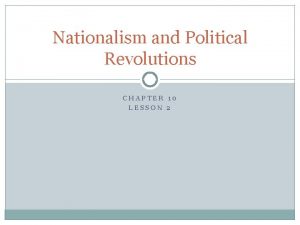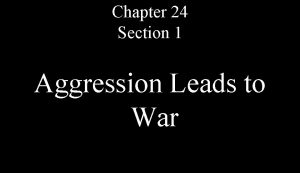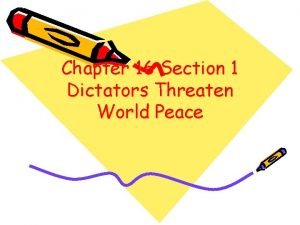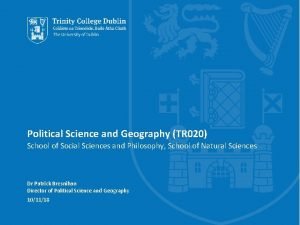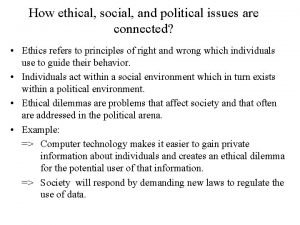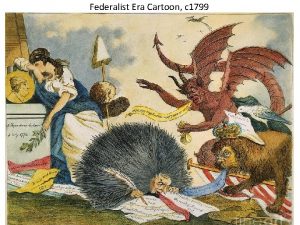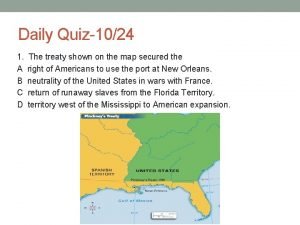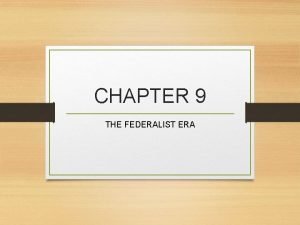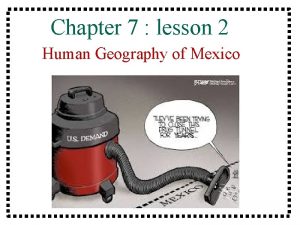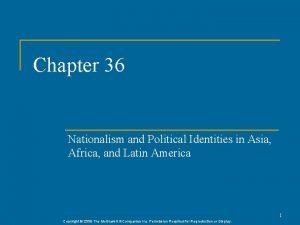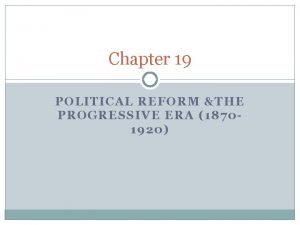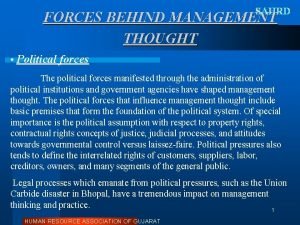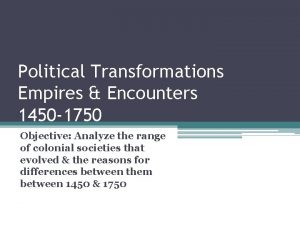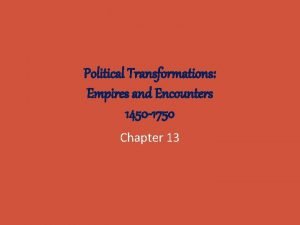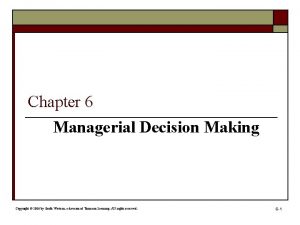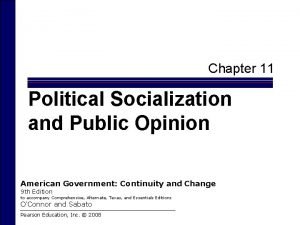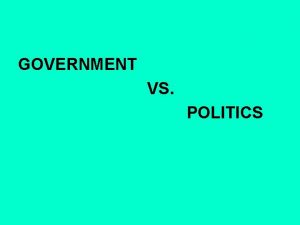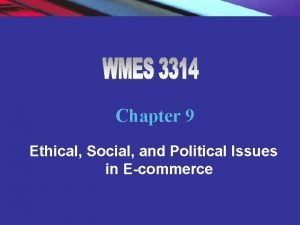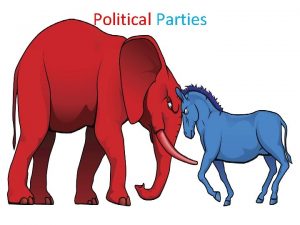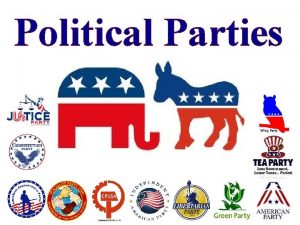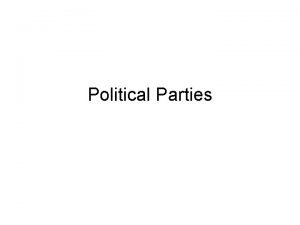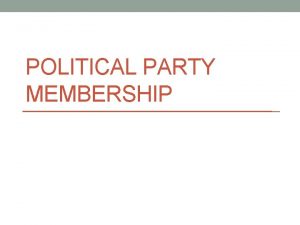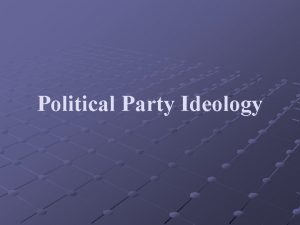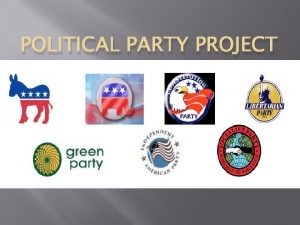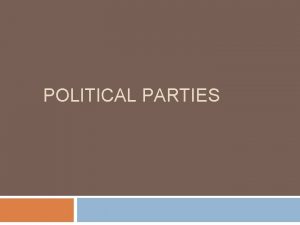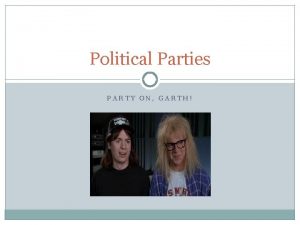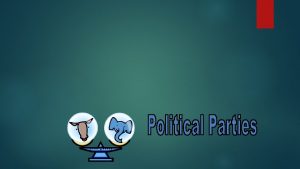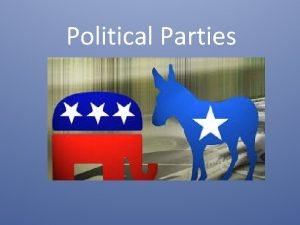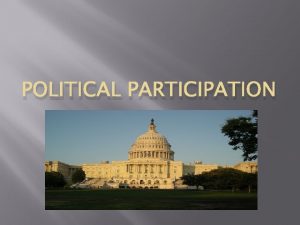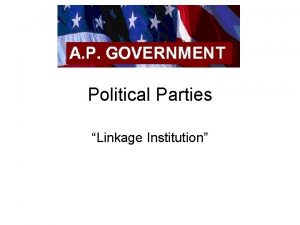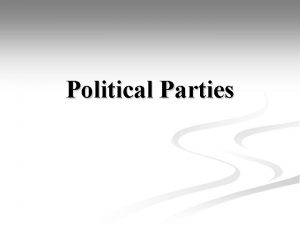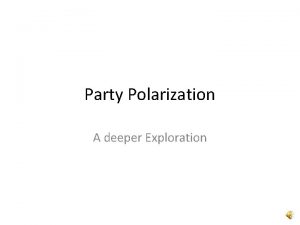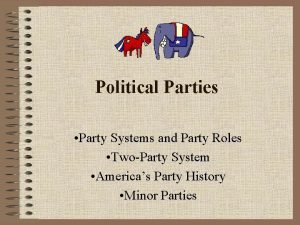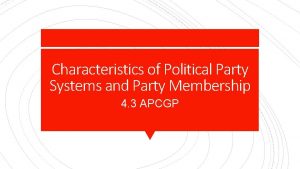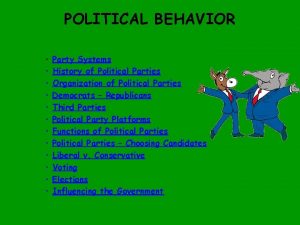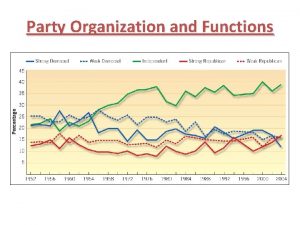Political Leadership in Canada Party Systems and Party







































































- Slides: 71

Political Leadership in Canada: Party Systems and Party Leadership Fall-Winter 2010 -11

Four Party Systems 1. 2. 3. 4. 1867 -1921 Two party, Patronage Era 1921 -1960 Regional Brokerage Era 1960 -1993 Pan-Canadian Politics 1993 - A new party system emerges that is highly regionalized, with new forms of party competition.

A Party System? A party system is distinguished by: n The character and number of individual parties. n The nature of competition among the parties and the issues that divide them. n Forms of party organization and activity. n Cycles of party mobilization of electorate. n Nature of party governance in office.

First Party System: Patronage n n n n 1867 -1921 Two-party system based on the historic parties of Confederation. Rather loose networks of local notables. Federal and provincial parties tied together. Leaders chosen by their parliamentary caucuses. Many argue that there were not major ideological differences between parties. Patronage was the organizational basis of the parties. Collapsed during and after First World War.

Origins of Canadian Political Parties Canada’s two dominant political parties, the Liberals and Conservatives, had their origins in Pre-Confederation politics, particularly in the Province of Canada. Still they were relatively loose associations of interests and personalities until about 1896. By that time, they had become somewhat more formalized groups and had extended their reach across the country.

Conservative Party n n Known as the Liberal-Conservative Party until the 1870 s. In the Province of Canada, it was a diverse coalition of Tories (John A. Macdonald) and moderate reformers from Canada West, and Bleus (George-Étienne Cartier) and business interests from Canada East.

John A. Macdonald PM 1867 -1873, 1878 -1891 Macdonald was one of the major advocates of and architects of Confederation. He skillfully led a diverse Conservative coalition, added by his Quebec lieutenant George-Étienne Cartier.

Liberal Party n n The Liberal Party had its origins in a loose coalition of forces (the Reform party) from the Province of Canada, including the Clear Grits of Canada West and the Parti Rouge of Canada East. The Pacific Scandal brought down the Macdonald government and brought the Liberals led by Alexander Mackenzie to power (1873 -1878). They then won the 1874 election.

Alexander Mackenzie PM 1873 -1878 Leader of the Opposition 1878 -80 His Liberal government: Introduced the secret ballot (1874) and reformed the electoral process.

The Return of John A. Macdonald returned to power from 1878 to 1891 (winning four consecutive elections). During these years, his government introduced the National Policy, involving: tariffs, n the building of the transcontinental railway n and the settlement of western Canada. n

After Sir John A. Macdonald After Macdonald’s death in 1891 he was succeeded by fellow Conservatives: n John Abbott, 1891 -92 n John Thompson, 1892 -94 n Mackenzie Bowell, 1894 -96 n Charles Tupper, 1896

Wilfrid Laurier PM 1896 -1911, remained Liberal leader and leader of opposition until his death in 1919. The Liberal Party was solidified by Laurier and after his election victory in 1896. Laurier turned the Liberal Party into a moderate brokerage party and successful governing coalition.

Brokerage Parties n n Canada’s main political parties are frequently described as brokerage parties. They seek to build broad coalitions of supporters, often reaching across political cleavages to unite all classes, all religious and ethnic groups, and as much as possible all regions. Macdonald’s successful governing coalition was diverse. Laurier brought the Liberals to power by watering down the his party’s ideological positions and becoming much like the Conservatives.

Traditional differences between Liberals and Conservatives? For about the first 100 years after Confederation: n n Conservatives developed a base among Protestants, favoured a strong central government, strong ties to Britain, tended to be suspicious of the United States and opposed to free trade. Liberals developed a base among Catholics, leaned toward provincial rights, pushed toward independence from Britain, promoted close relations with US, and favoured free trade.

Ideological divisions Liberals business liberalism n welfare liberalism n Conservatives toryism n business liberalism n

Debating Free Trade n n n Liberals leaned toward autonomy from Britain and freer trade with US, while Conservatives resisted these trends. Laurier and the Liberals campaigned on freer trade with US in 1891 and 1911. Both times they lost to the Conservatives.

1911 Election n Laurier to: and the Liberals were defeated due – proposed Reciprocity deal with US – Naval Service Bill n The Liberals were squeezed between pro. British sentiment and French Canadian nationalism. n The Liberals lost Ontario and saw their base in Quebec seriously eroded.

Robert Borden PM 1911 -1917 Conservative 1917 -1920 Unionist “No truck or trade with the Yankees” - 1911

1917 Election: A Divided Country The First World War and the battle over conscription led to the creation of a Union Government, comprised of the Conservatives and English-speaking Liberals. n Laurier and many Frenchspeaking Liberals opposed conscription. n Of 235 seats, the Unionists won 153 and the Liberals 82. n In Quebec, the Liberals won 62 of 65 seats. n

Civil Service Reform n Civil Service Amendment Act of 1908 n Civil Service Act of 1918 n These acts gradually developed a federal public service based on the merit principle rather than partisan ties and patronage appointments.

Second Party System: Regional Brokerage n n n n n 1921 -1960 Women gain right to vote. First major third party challenge, the Progressive Party. Emergence of Co-operative Commonwealth Federation (CCF) – 1932 and Social Credit - 1935. Regional politics but also class politics, farmer and working class. Changing role of the state in economy. Governing parties brokered regional interests through powerful regional political bosses in cabinet. Movement toward delegate conventions to choose party leaders. Quebec became Liberal bastion. Growing separation of federal and provincial politics. Radio becomes an election campaign tool

1921 Election: Third Party Challenge Seats Votes Liberals 117 41% Progressives 64 23% Conservatives 50 30% Others 4 6%

The Progressives n The Progressives were to some extent a splinter group that broke from the Liberal Party in protest against the Liberal drift away from free trade policies and attention to agrarian interests. n Moderate Progressive leaders such as Thomas Crerar and Robert Forke gradually returned to the Liberal Party.

Multi-party politics n Even though the Progressives faded away rather quickly, they ushered in the era of multi-party politics. n No longer would Canadian electoral politics be simply a two party affair. n New parties raised regional, class and ideological critiques of the two traditional parties.

From 1867 to 1921 Canada and its political system underwent a massive transition. n From four provinces to nine. n Population grew from 3. 5 to 8. 8 million. n Franchise had become much broader and electoral process had been transformed. n The civil service was now expected to be neutral and based on merit rather than partisan and based on patronage.

Class Struggle and Political Reform n n n Farmer’s Siege of Ottawa, 1910 Winnipeg General Strike, 1919 Formation of Progressive Party, 1920 Communist Party of Canada, 1921 Turmoil of the Great Depression: formation of Social Credit, Cooperative Commonwealth Federation, On-to-Ottawa Trek. Rise of industrial unions, 1930 s and 40 s.

New form of brokerage politics n In an increasingly urbanized and industrialized country, the political parties had to broker not only linguistic and religious cleavages, but also the class cleavage. n As the country grew (from 4 provinces to 9), the regional cleavage became more difficult to manage.

William Lyon Mackenzie King Liberal PM 1921 -1926, 1926 -1930, 1935 -1948 Industry and Humanity, 1918 “conscription if necessary, but not necessarily conscription” WWII

Richard B. Bennett Conservative PM 1930 -1935 Bennett New Deal "The old order is gone…I am for reform. And in my mind, reform means government intervention. It means government control and regulation. It means the end of laissezfaire. " - 1935 http: //www. collectionscanada. gc. ca/primeministers/h 4 -4049 -e. html

W. L. M. K. n The turmoil of the Great Depression brought Mackenzie King back to power in 1935, but his government did little to directly address the economic problems. n Reductions in trade barriers with the US were pursued and implemented. n Not until during and after WWII would King take up the issue of social reforms.

The Progressive Conservatives n In 1942, long-time Manitoba Premier John Bracken won the leadership of the Conservative Party and n the party added “Progressive” to their name.

The Shift to Keynesianism n n n Great Depression of the 1930 s War economy, 1939 -45 Foreign models: Franklin Delano Roosevelt (1933 -45) in USA, Labour Party government (1945 -51) in Britain. Prestige of our good ally, the Soviet Union! Rise of the CCF Rise of industrial unionism

Louis St. Laurent Liberal PM 1948 -1957 “Uncle Louis” “the Liberal Party’s fusion with the Canadian state and the business community was almost taken for granted” (Clarkson, 2005: 11).

John Diefenbaker Progressive Conservative PM 1957 -1963 Party leader 1956 -67 The Diefenbaker “Interlude” The Conservatives, led by Diefenbaker, won the largest electoral landslide in Canadian history in 1958, but were reduced to a minority in 1962.

Impact of Diefenbaker n Diefenbaker added an element of prairie populism to the Progressive Conservatives, while still maintaining a significant tory touch. n Under Diefenbaker, the Progressive Conservatives created a solid base in western Canada.

The Tory Syndrome n If the Liberals were ‘the government party’, the Progressive Conservatives were rather entrenched as the opposition party. n The Tory Syndrome - The Conservative party’s tendency toward infighting and disputes over leadership.

Third Party System: Pan-Canadian Politics n n n n n 1960 -1993 End of racial discrimination in voter rights. Regional issues now ‘managed’ through executive federalism rather than within governing party. Diefenbaker sweep of 1958 ushers in PC strength on prairies. CCF becomes NDP in 1961. Social Credit fades away late 70 s. In 1970, voting age reduced from 21 to 18. Significant party finance reforms are introduced. Disentangling of federal and provincial party organizations. Opinion polling and television advertising shape election campaigns. First televised leaders’ debate - 1968.

Third Party System n n n By the early 60 s television was altering the political process. Campaigns were increasingly being turned over to the professional pollsters, advertisers and public relations experts. The party leader (and his image and media performance) became increasingly important. Regionalism could no longer be brokered through cabinet ministers, the provincial Premiers had become national players. Provincial parties were also increasingly distinct from federal parties.

Third Party System n n The 1957 election was the first Canadian campaign to be covered by television. Diefenbaker used the medium more successfully than St. Laurent. Polling became seriously used by the Liberals in the early 60 s. TV advertising becomes vital (and expensive) tool.

Impact of Third Party System n n n Television coverage increased the focus and emphasis on the party leaders. First leaders debate – 1968. The parties used the national networks to wage national pan-Canadian campaigns (at least outside Quebec). Opinion polling largely replaced regional lieutenants, MPs and party grassroots in role of keeping tabs on the pulse of the nation.

Social Transformation of the 60 s n Quiet Revolution in Quebec n Liberalization of Canada’s immigration policy in 1967 n Baby boomers come of age n Social movements of the late 60 s n Labour militancy from late 60 s to mid-70 s

Lester Pearson Liberal PM 1963 -68 He was never able to win a majority government, forming minority governments after the 1963 and 65 elections.

The Growth of Social Programs Old Age Pensions (1927) Blind Persons’ Allowance (1937) Unemployment Insurance (1941) Family Allowances (1944) Old Age Security (1951) Hospital Insurance (1957) Canada Pension Plan (1966) Canada Assistance Plan (1966) Guaranteed Income Supplement (1966) Medical Insurance (1968) U. I. expanded (1971)

Pierre Trudeau Liberal PM 1968 -1979, 1980 -1984 Despite his lengthy period in power, he was never able to win back-to-back majority governments.

1969 White Paper Pierre Trudeau and Indian Affairs Minister Jean Chrétien issued a “Statement of the Government of Canada on Indian Policy, 1969. ” n It proposed to get rid of Indian Act and Indian Status and treat Aboriginals the same as other Canadians. n Natives saw this as a proposal for assimilation and reacted strongly against it. The proposal was dropped. n

Trudeau and Liberal Flexibility In 1974, campaigning against Robert Stanfield and the Progressive Conservatives, Trudeau lashed out at the PC proposal for wage and price controls to tackle inflation. Trudeau: “What’s he [Stanfield] going to freeze? He’s going to freeze your wages. ” n In 1975, having won the election, Trudeau introduced wage and price controls and attempted to freeze workers’ wages. n

Trudeau and Regionalism In 1968, Trudeau was able to win a majority govt, but even at the height of ‘Trudeaumania’ the Liberals won majorities of the seats in Quebec, Ontario and BC, but no other provinces. n After losing the 1979 election, the Liberals returned with a majority govt in 1980, with two seats in Manitoba, but none in the other three western provinces. n By 1984, Trudeau left the Liberals decimated in western Canada. n The patriation of the constitution was highly controversial in Quebec. n

John Turner becomes PM http: //archives. cbc. ca/politics/prime_ministe rs/clips/13052/ n 1984 leaders debate http: //archives. cbc. ca/politics/federal_politic s/clips/15790/

The Mulroney ‘Coalition’ n Mulroney was able to hold the Conservatives’ western Canadian base, but add Ontario and Quebec. n In 1984, the PCs won 211 of 282 seats, with 50% of the national vote, taking a majority of the seats in every province and sweeping the territories.

The Mulroney ‘Coalition’ n In 1988, the PCs were re-elected with a majority government (with 43% of the vote), but with a clear majority of the seats from only two provinces, Alberta and Quebec. n The subsequent collapse of PC support in these two provinces would not only decimate the PCs, but lead to the formation of two new parties.

Canadian Business Embraces Continentalism n Business groups like the BCNI (which later becomes the CCCE) and think tanks like C. D. Howe Institute helped generate a business consensus in favour of free trade with the US.

Canadian State Embraces Continentalism n n Royal Commission on the Economic Union and Development Prospects for Canada, Macdonald Commission, 1982 -85 Canada-US Free Trade Agreement (FTA), 1989 [http: //archives. cbc. ca/politics/prime_ministers/clips/9807/] n n North American Free Trade Agreement (NAFTA), 1994 Meanwhile, GATT was transformed into the World Trade Organization (WTO) in 1994.

The FTA and NAFTA: More than ‘free trade’ agreements Along with trade in goods, these deals cover: n services n investment and investor rights n national procurement policies n intellectual property rights n energy provisions (Canadian govts can not act to give Canadians preferential access to Canadian energy, such as oil. US consumers and business have their access to Canadian energy protected. )

Brian Mulroney n The 1988 Leaders Debate

Fourth Party System: Regionalized Party Competition l l l l 1993 Sudden emergence of Bloc Québécois and Reform Party. Charter of Rights has completed development of universal franchise for adults. Development of permanent voters list. Emergence of new communications technologies. Major changes in party finance regulations. Parties increasingly choosing their leaders by system of one-member-one-vote rather than delegated conventions.

l l l Formed in 1991, led by Lucien Bouchard, formerly a member of Mulroney’s cabinet. The BQ caucus was initially comprised of former PCs and Liberals. The first elected BQ MP was Gilles Duceppe, winning a by-election in 1990. After Bouchard left to become Quebec Premier, the BQ was briefly led by Michel Gauthier, 1996 -97. Gilles Duceppe leader since 1997.

Bloc Québécois Election Seats Vote (Quebec) 1993 54 49% 1997 44 38% 2000 38 40% 2004 54 49% 2006 51 42%

l l l Formed in 1987, led by Preston Manning. Ran only in the four western provinces in 1988. Won a federal byelection in 1989. Became the Canadian Alliance in 2000 with Stockwell Day as leader.

Reform/Canadian Alliance/CPC Election Seats Vote 1993 52 18. 7% 1997 60 19. 4% 2000 66 25. 5% 2004 99 29. 6% 2006 124 36. 3%

1993 Election results Liberals BQ Reform NDP PC 41% 13. 5% 18. 7% 6. 9% 16% 177 seats 54 52 9 2

Chrétien’s Liberal Majority The Liberals were able to win three straight majority governments (1993, 1997, 2000), due to two related facts. n the weak and divided opposition. n Liberal dominance of Ontario (98 out of 99 seats; 101/103; 100/103). Thus the Liberals won majorities with only 41. 3%, 38. 5% and 40. 8% of the federal vote.

The Chrétien Government “The Reagan-Thatcher revolution was so successful that it permanently undermined the traditional social democratic/left-liberal consensus in a number of democratic countries. ” n “It worked domestically to undermine the leftliberal- or social-democratic consensus, causing those parties to simply stop fighting and adopt much of the winning conservative agenda. ” n “Socialists and liberals began to stand for balanced budgets, the superiority of markets, welfare reversal, free trade and some privatization” (Harper, 2003: 74). n

Federal Govt Response Massive spending cuts, especially in 1995 budget. Canada Health and Social Transfer (CHST) replaces EPF and Canada Assistance Plan (CAP)

Federal Govt Response “The 1995 federal budget marked a fundamental shift in the role of the federal state in Canada” (Mc. Bride, 2005: 106).

1995 Federal Budget Speech l l l l “Relative to the size of our economy, program spending will be lower in 1996 -97 than at any time since 1951. ” “We are acting on a new vision of the role of government in the economy. ” “overall departmental spending will be cut by almost 19 per cent in just three years. ” “the public service will be reduced by some 45, 000 positions, of which 20, 000 will be eliminated by the summer of next year. ” “The government is committed to privatizing and commercializing government operations wherever that is feasible and appropriate. ” “we believe that the restrictions attached by the federal government to transfer payments in areas of clear provincial responsibility should be minimized. ” “In 1997 -98, the Canada Social Transfer will be…about $4. 5 billion less than what would have been transferred under the existing system. ”

Post-Referendum Response n n The federal government continued to download powers to all of the provinces. The federal government passed a resolution recognizing Quebec as a distinct society (1995). The federal government passed a resolution (1996) declaring that it would not support future constitutional amendments without the consent of Quebec (and Ontario, BC, with regional vetoes for the prairies and the Atlantic provinces). The Clarity Act (2000).

Conservative Party of Canada: Merger 2003 After years of division on the right: n Peter Mac. Kay as leader of the Progressive Conservatives n and Stephen Harper of the Canadian Alliance n successfully merged their two parties in 2003.

“the Three Sisters” Stephen Harper and Tom Flanagan, in a series of speeches and articles, have described the kind of conservative coalition necessary to build a majority government. populists, primarily in the west, but also in rural Ontario • traditional ‘Tories’ in Ontario and Atlantic Canada • Quebec nationalists •

Building a Conservative Majority? n In 2004, the CPC was able to break into Ontario, with 24 seats. This expanded to 40 in 2006 and then 51 in 2008. n The Conservatives won 10 seats in Quebec in 2006 and again in 2008.

A Return to Brokerage Politics? n The Reform Party-Canadian Alliance was formed in protest against the brokerage politics of the Progressive Conservative Party. n However, the new Conservative Party of Canada seems determined to act as a brokerage party, even to recreate the Mulroney coalition.

Conservative Govt of Stephen Harper Gave Quebec a formal international role in UNESCO (the United Nations Educational, Scientific and Cultural Organization). n Parliamentary motion passed: "That this House recognize that the Québécois form a nation within a united Canada. " n
 Fourth party logistics advantages and disadvantages
Fourth party logistics advantages and disadvantages Left wing and right wing spectrum
Left wing and right wing spectrum Populist cartoons
Populist cartoons A political party is an association of
A political party is an association of What is the main idea?
What is the main idea? Objectives of political party
Objectives of political party Create a political party project
Create a political party project Kathy cocuzzi political party
Kathy cocuzzi political party Political party
Political party Political party
Political party Political party project
Political party project Political party organization chart
Political party organization chart George washington political party
George washington political party Graham sumner roman
Graham sumner roman Farmer protest cartoons
Farmer protest cartoons Transactional leadership
Transactional leadership Adaptive leadership style
Adaptive leadership style Adaptive leadership vs situational leadership
Adaptive leadership vs situational leadership 600 million
600 million Types of political systems
Types of political systems Decision support systems and intelligent systems
Decision support systems and intelligent systems Dicapine
Dicapine Embedded systems vs cyber physical systems
Embedded systems vs cyber physical systems Engineering elegant systems: theory of systems engineering
Engineering elegant systems: theory of systems engineering Wettest vegetation region in canada
Wettest vegetation region in canada United states and canada physical map
United states and canada physical map What is latitude
What is latitude Effects of ww1
Effects of ww1 Settlement patterns
Settlement patterns Quebec separating from canada pros and cons
Quebec separating from canada pros and cons The physical geography of the united states and canada
The physical geography of the united states and canada Tom thoon
Tom thoon Unit 2 the united states and canada worksheet answers
Unit 2 the united states and canada worksheet answers Chinese immigration to canada push and pull factors
Chinese immigration to canada push and pull factors Swana region
Swana region Sociology as a social science
Sociology as a social science Social work and other social sciences
Social work and other social sciences Economics and political science relationship
Economics and political science relationship Unethical political tactics and strategies
Unethical political tactics and strategies Sociology vs political science
Sociology vs political science Difference between political science and psychology
Difference between political science and psychology Ap gov unit 4 political ideologies and beliefs
Ap gov unit 4 political ideologies and beliefs Opportunities, challenges, and power of media information
Opportunities, challenges, and power of media information Is israel in africa or asia
Is israel in africa or asia French revolution political spectrum
French revolution political spectrum Chapter 35 nationalism and political identities in asia
Chapter 35 nationalism and political identities in asia A packaging that promotes social and political causes.
A packaging that promotes social and political causes. Aggressive actions taken in the 1920s and 1930s
Aggressive actions taken in the 1920s and 1930s Japanese militarists political movements and beliefs
Japanese militarists political movements and beliefs Dust bowl migration map
Dust bowl migration map Relationship between political science and geography
Relationship between political science and geography Which political cultural and economic characteristics
Which political cultural and economic characteristics Political cartoons
Political cartoons How ethical social and political issues are connected
How ethical social and political issues are connected Political and physical features of latin america
Political and physical features of latin america What so
What so Alien and sedition acts political cartoon
Alien and sedition acts political cartoon Alien and sedition acts political cartoon
Alien and sedition acts political cartoon What influenced mexico’s political and social structures?
What influenced mexico’s political and social structures? Chapter 36 nationalism and political identities in asia
Chapter 36 nationalism and political identities in asia Chapter 19 political reform and the progressive era
Chapter 19 political reform and the progressive era Political economic and social forces of management
Political economic and social forces of management Divertido superlative
Divertido superlative Political transformations empires and encounters
Political transformations empires and encounters Chapter 5 political transformations empires and encounters
Chapter 5 political transformations empires and encounters Characteristics of decision making
Characteristics of decision making Six decision making steps
Six decision making steps Public opinion and political socialization
Public opinion and political socialization Aqa a level english literature b poetry anthology
Aqa a level english literature b poetry anthology Political comparative and superlative
Political comparative and superlative Political direction
Political direction Ethical social and political issues in e-commerce
Ethical social and political issues in e-commerce

